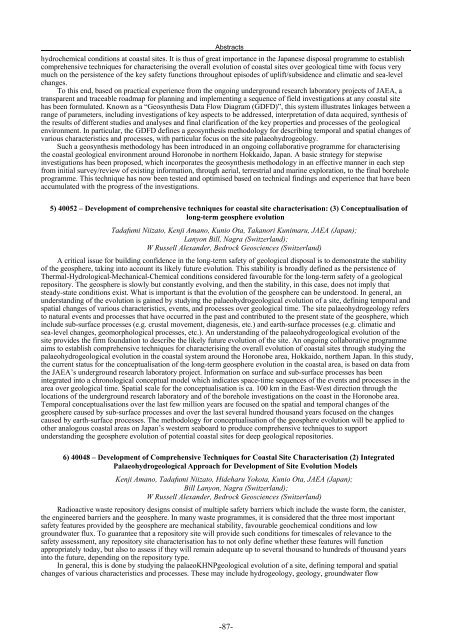ASME Message
ASME Message
ASME Message
You also want an ePaper? Increase the reach of your titles
YUMPU automatically turns print PDFs into web optimized ePapers that Google loves.
Abstracts<br />
hydrochemical conditions at coastal sites. It is thus of great importance in the Japanese disposal programme to establish<br />
comprehensive techniques for characterising the overall evolution of coastal sites over geological time with focus very<br />
much on the persistence of the key safety functions throughout episodes of uplift/subsidence and climatic and sea-level<br />
changes.<br />
To this end, based on practical experience from the ongoing underground research laboratory projects of JAEA, a<br />
transparent and traceable roadmap for planning and implementing a sequence of field investigations at any coastal site<br />
has been formulated. Known as a “Geosynthesis Data Flow Diagram (GDFD)”, this system illustrates linkages between a<br />
range of parameters, including investigations of key aspects to be addressed, interpretation of data acquired, synthesis of<br />
the results of different studies and analyses and final clarification of the key properties and processes of the geological<br />
environment. In particular, the GDFD defines a geosynthesis methodology for describing temporal and spatial changes of<br />
various characteristics and processes, with particular focus on the site palaeohydrogeology.<br />
Such a geosynthesis methodology has been introduced in an ongoing collaborative programme for characterising<br />
the coastal geological environment around Horonobe in northern Hokkaido, Japan. A basic strategy for stepwise<br />
investigations has been proposed, which incorporates the geosynthesis methodology in an effective manner in each step<br />
from initial survey/review of existing information, through aerial, terrestrial and marine exploration, to the final borehole<br />
programme. This technique has now been tested and optimised based on technical findings and experience that have been<br />
accumulated with the progress of the investigations.<br />
5) 40052 – Development of comprehensive techniques for coastal site characterisation: (3) Conceptualisation of<br />
long-term geosphere evolution<br />
Tadafumi Niizato, Kenji Amano, Kunio Ota, Takanori Kunimaru, JAEA (Japan);<br />
Lanyon Bill, Nagra (Switzerland);<br />
W Russell Alexander, Bedrock Geosciences (Switzerland)<br />
A critical issue for building confidence in the long-term safety of geological disposal is to demonstrate the stability<br />
of the geosphere, taking into account its likely future evolution. This stability is broadly defined as the persistence of<br />
Thermal-Hydrological-Mechanical-Chemical conditions considered favourable for the long-term safety of a geological<br />
repository. The geosphere is slowly but constantly evolving, and then the stability, in this case, does not imply that<br />
steady-state conditions exist. What is important is that the evolution of the geosphere can be understood. In general, an<br />
understanding of the evolution is gained by studying the palaeohydrogeological evolution of a site, defining temporal and<br />
spatial changes of various characteristics, events, and processes over geological time. The site palaeohydrogeology refers<br />
to natural events and processes that have occurred in the past and contributed to the present state of the geosphere, which<br />
include sub-surface processes (e.g. crustal movement, diagenesis, etc.) and earth-surface processes (e.g. climatic and<br />
sea-level changes, geomorphological processes, etc.). An understanding of the palaeohydrogeological evolution of the<br />
site provides the firm foundation to describe the likely future evolution of the site. An ongoing collaborative programme<br />
aims to establish comprehensive techniques for characterising the overall evolution of coastal sites through studying the<br />
palaeohydrogeological evolution in the coastal system around the Horonobe area, Hokkaido, northern Japan. In this study,<br />
the current status for the conceptualisation of the long-term geosphere evolution in the coastal area, is based on data from<br />
the JAEA’s underground research laboratory project. Information on surface and sub-surface processes has been<br />
integrated into a chronological conceptual model which indicates space-time sequences of the events and processes in the<br />
area over geological time. Spatial scale for the conceptualisation is ca. 100 km in the East-West direction through the<br />
locations of the underground research laboratory and of the borehole investigations on the coast in the Horonobe area.<br />
Temporal conceptualisations over the last few million years are focused on the spatial and temporal changes of the<br />
geosphere caused by sub-surface processes and over the last several hundred thousand years focused on the changes<br />
caused by earth-surface processes. The methodology for conceptualisation of the geosphere evolution will be applied to<br />
other analogous coastal areas on Japan’s western seaboard to produce comprehensive techniques to support<br />
understanding the geosphere evolution of potential coastal sites for deep geological repositories.<br />
6) 40048 – Development of Comprehensive Techniques for Coastal Site Characterisation (2) Integrated<br />
Palaeohydrogeological Approach for Development of Site Evolution Models<br />
Kenji Amano, Tadafumi Niizato, Hideharu Yokota, Kunio Ota, JAEA (Japan);<br />
Bill Lanyon, Nagra (Switzerland);<br />
W Russell Alexander, Bedrock Geosciences (Switzerland)<br />
Radioactive waste repository designs consist of multiple safety barriers which include the waste form, the canister,<br />
the engineered barriers and the geosphere. In many waste programmes, it is considered that the three most important<br />
safety features provided by the geosphere are mechanical stability, favourable geochemical conditions and low<br />
groundwater flux. To guarantee that a repository site will provide such conditions for timescales of relevance to the<br />
safety assessment, any repository site characterisation has to not only define whether these features will function<br />
appropriately today, but also to assess if they will remain adequate up to several thousand to hundreds of thousand years<br />
into the future, depending on the repository type.<br />
In general, this is done by studying the palaeoKHNPgeological evolution of a site, defining temporal and spatial<br />
changes of various characteristics and processes. These may include hydrogeology, geology, groundwater flow<br />
-87-


